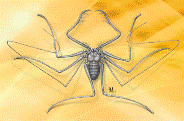Papers in the Biological Sciences

Eileen Hebets Publications
Document Type
Article
Date of this Version
2021
Citation
Analytical and Bioanalytical Chemistry 413:26 (2021), pp. 6605–6615.
doi: 10.1007/s00216-021-03626-8
Abstract
Loxosceles reclusa, or brown recluse spider, is a harmful household spider whose habitat extends throughout the Midwest in the USA and other regions in the world. The pheromones and other biomolecules that facilitate signaling for brown recluses and other spider species are poorly understood. A rapid and sensitive method is needed to analyze airborne spider signaling biomolecules to better understand the structure and function of these biochemicals in order to control the population of the spiders. In this study, we developed a novel headspace solid-phase microextraction (HS-SPME)-GC/MS method to analyze potential pheromones and biomolecules emitted by the brown recluse spider. The method is highly selective and sensitive for biomolecule identification and quantification from a single live spider. Using this novel nondestructive HS-SPME-GC/MS technique, we identified 11 airborne biomolecules, including 4-methylquinazoline, dimethyl sulfone, 2-methylpropanoic acid, butanoic acid, hexanal, 3-methylbutanoic acid, 2-methylbutanoic acid, 2,4-dimethylbenzaldehyde, 2-phenoxyethanol, and citral (contains both isomers of neral and geranial). Some of these airborne biomolecules were also reported as semiochemicals associated with biological functions of other spiders and insects. The method was also applied to study the airborne biochemicals of Plectreurys tristis, another primitive hunting spider with a poor web, enabling quantitation of the same compounds and demonstrating a difference in signaling molecule concentrations between the two species. This method has potential application in the study of pheromones and biological signaling in other species, which allows for the possibility of utilizing attractant or deterrent functions to limit household populations of harmful species.
Included in
Animal Sciences Commons, Behavior and Ethology Commons, Biology Commons, Entomology Commons, Genetics and Genomics Commons


Comments
Copyright © 2021 Springer-Verlag GmbH Germany, part of Springer Nature. Used by permission.